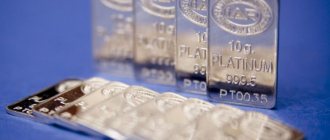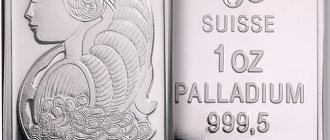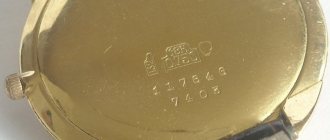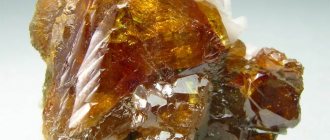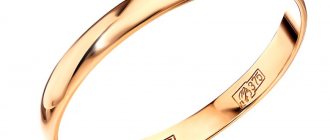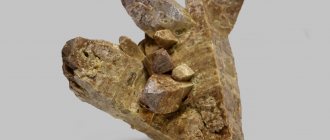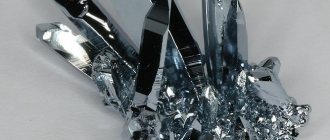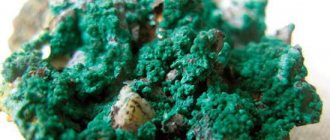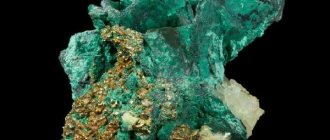Post updated: Oct 9, 2020
Many people think that platinum and white gold are the same thing. But this statement is erroneous, because the first is a noble and expensive metal, standing apart from gold. For some time after its discovery, platinum was neglected, but scientific research helped discover new properties of the metal, which gave impetus to its use in jewelry. Outwardly, it resembles silver, but has better performance and properties, even the minimum standard of platinum is quite high, at least 850.
Externally, the material looks like a white-gray metal with a characteristic shine. It is usually mined in the form of ore or nugget. Platinum is rightfully considered the most durable of the precious metals, due to its high density.
Platinum has useful properties:
- It is difficult to damage;
- It has high anti-corrosion properties;
- High temperature threshold for melting;
- Resistant to chemical influences;
Platinum samples
Decorations and jewelry are not made from completely pure metal. In production, an alloy is used - additional metals that dilute the pure material in order to obtain the necessary properties for the entire alloy. Platinum samples are marked on the finished product, which indicate how much pure metal is in the alloy, but for your own confidence you need to know what they are.
As mentioned above, in its pure form this raw material looks like a gray-white plastic metal. It does not dissolve in any acids or alkaline compounds, with the only exception being “royal vodka”. Such products shine perfectly, and to achieve maximum reliability and strength, platinum is also diluted with copper, rhodium, gallium, rhenium, rhodium, tungsten, and the samples of products depend on their share. To further improve the properties, additive components can also be included in the alloy: copper, iridium, gold, etc.
As with gold hallmarks, platinum also has three hallmark options depending on the platinum alloys. The spool sampling system was initially used in Russia, and after 1927 it was replaced by the metric one. In the USA, the carat test has always been used, but if desired, the indicators of any of the systems can be converted to another. For example, the 950th standard will correspond to the 91st in the spool system and the 22nd in the karat system.
Similarity with 985 sample, how to recognize
High-grade gold consists of 95% precious metal, 5% additives of silver and copper. Such impurities give the alloy hardness, which makes it similar to 985 standard. Both alloys meet the physical characteristics of pure gold due to their low additive content.
Such a simple composition makes the alloys soft, which is why products are susceptible to rapid deformation. At the same time, objects made of pure precious metal are not subject to corrosion. Both samples are distinguished by their characteristic natural bright yellow color.
Only a professional can distinguish them, since the difference in impurities is minimal.
Ring 985 gold
Standard platinum samples of Russia
According to the legal standard of the Russian Federation, it is customary to use 850, 900 and 950 samples of platinum. The platinum sample, designated 950, contains 95% metal. This is the most popular metal sample and is used for making jewelry.
The 900th contains 90% metal. This platinum sample is used somewhat less frequently than 950, but high-quality and sought-after jewelry is also made from it. Its disadvantage is less shine and brightness of the white color.
The 850-grade material contains 85% pure raw materials. It is practically not used for the production of jewelry, because its properties are much worse than those of higher standards - the products turn out duller and more “silver”. There is no 875 standard for this metal, no matter how platinum with such a content is advertised.
Types of marks on platinum products in Russia.
Platinum alloys serve as materials for the manufacture of various products: necklaces, earrings, rings. It is considered the best alloy for preserving precious stones, because it holds them very tenaciously. The properties of the alloy with its content also depend on the alloy. For example, copper in an alloy gives it softness and elasticity, and also gives a lower melting temperature. Cobalt further improves mechanical properties, while iridium and tungsten increase the service life of finished products. The purity of platinum is usually indicated on finished jewelry, so you can always see what percentage of pure material your piece contains.
A foreign version of the stamp with hallmark.
So, platinum is the most durable and at the same time rare precious metal in the world. The most expensive jewelry in the world is created from platinum alloys, and it is also the best setting for precious stones, because its color perfectly emphasizes the dignity and beauty of diamonds. This material is also used in industry due to its high density and, as a result, excellent hardness.
Platinum is very difficult to purchase on the precious metals market, because demand many times exceeds supply, and this is justified, because to extract just one ounce of platinum (31 grams) it is necessary to process about ten tons of ore.
It is also used in medicine and high technology, because its properties are unique and are not repeated in any other metal. A unique metal is the key to the best products of high standard; it is this fact that allows platinum to be called the queen of all metals.
Features and properties of platinum
Platinum is an expensive material with a beautiful white-gray color. It has a characteristic silvery sheen. Interestingly, among all the precious metals, platinum is the most durable due to its density.
We recommend reading: Marking gemstones
The main features of the element are as follows:
- Excellent anti-corrosion properties.
- Resistance to mechanical damage.
- Resistant to chemical damage.
- High melting point threshold (this property is important for metal smelting).
Most often, the material is mined in the form of nuggets or ore. It is subsequently processed and used for various purposes, including in an alloy called “white gold.”
History of platinum
Researchers were able to prove that the ancient Egyptians used platinum alloys to create jewelry. The Incas also used it for their own purposes, but then people forgot it and did not use it as a raw material in their work.
In modern history, platinum was discovered by the Spaniards who visited South America. During the process of mining gold, a metal that looked like silver was found. After experiments, it was recognized as refractory and unnecessary for production, which is why the price was half that of silver.
The situation changed a little when platinum was discovered to be mixed with gold. Unscrupulous jewelers began to create gold jewelry with an admixture of white metal and pass it off as purely gold. After some time, this scam was exposed, the king banned the import of raw materials to Spain, and all available metal was drowned in the ocean.
At the end of the 18th century, platinum began to be widely used in jewelry, and King Louis XVI even called it the only royal metal. At the beginning of the 18th century, placers of raw materials were found in Russia, but for a long time, Ural hunters used its grains as shot for weapons.
In the 19th century, 95% of all platinum mined was Russian, and the first products made from it were presented personally to Alexander I.
Popularity of the sample during the years of the USSR
Today it is quite difficult to find gold with the rare 950 marking. These products have been items in private antique collections for several decades. Metal with this mark was used for making jewelry in the Soviet Union for only a few years. You could only see such markings on a wedding ring made in the 60-70s.
The decoration was quite thick, could weigh at least 8 grams, but was not particularly practical or hard.
Wedding rings in those days were a valuable attribute, which is why they were made from almost pure precious metal, despite its physical properties.
Soviet era gold jewelry
Interesting about platinum
Throughout its history, this metal has acquired interesting and curious facts.
Platinum is found 30 times less frequently than gold; to extract just 31 grams, more than 10 tons of ore must be processed. Now the difference between the cost of platinum and gold is about $270, and there were periods when it cost $1000 more than gold.
The jewelry uses an almost pure version of iron, without many impurities, as, for example, in the case of gold and silver, which ensures a consistently high standard of platinum in any jewelry.
Platinum has a higher density and therefore the same products made of gold and platinum will have different weights. The color is reminiscent of white gold, but these are completely different things, because platinum is an independent noble metal, and white gold is an alloy of gold with silver, palladium or nickel.
Metal never served as a material for making money; some mint houses minted such coins, but they were intended for private collections and not for everyday use. At the moment, the demand for rare metal is much higher than the supply level.
The most commonly used is 950, the highest standard (for jewelry) of platinum, and South Africa produces the most raw materials.
Application options
At a time when platinum was greatly undervalued, it cost half as much as silver, for its external resemblance to which it got its name (from Spanish the word “plata” translates as “little silver.” Some jewelers took advantage of this and learned to fuse the metal with gold, they made skillful counterfeits.
Otherwise, platinum had limited use - it was mainly used in only two areas : in the creation of chemical equipment and devices, and also as a catalyst. However, now there are many more options for its use.
Science and technology
Most of the mined platinum goes to the development of science and technology. It can be used in the production of high-strength steels as an alloying additive. In addition, the following items are made from it:
- vessels and stirrers used in the production of parts for optical instruments;
- crucibles, spoons and other laboratory utensils that are resistant to temperature and chemical reagents;
- magnets;
- mirrors for laser technology;
- electrical contacts;
- galvanic coatings;
- retorts for the distillation of acids;
- electrodes for producing various reagents, primarily hydrogen peroxide;
- insoluble anodes;
- heating elements;
- electronic devices;
- coatings for microwave equipment parts.
When metal compounds are reduced, a fine powder is obtained, which is an active catalyst. Its alloy with rhodium can perform the same functions. A catalyst increases the efficiency of a reaction to produce substances such as:
- nitric acid, which can then be used in fertilizers;
- silicones, which have a wide range of applications - from the production of cosmetic products to aircraft engine parts;
- gasoline and petrochemical raw materials, on the basis of which plastics, rubber, and polyester fibers are produced.
Platinum is also used as an automobile catalyst installed between the engine and muffler. It captures more than 90% of nitrogen and carbon oxides, hydrocarbons and other harmful components in exhaust gases and converts them into less hazardous substances.
Also in the automotive industry, platinum spark plugs, characterized by extended service life, and various sensors are used. The latter ensure the correct proportions of mixing fuel and air and are used in climate control systems.
Fields of medicine
Platinum is a popular material in dentistry. Most often, bushings are made from it for the gold pin that connects the artificial porcelain tooth to the base of the prosthesis. Another dental use of platinum is as an additive to gold alloys and as a foil used in the manufacture of porcelain teeth and crowns.
This is possible due to the fact that the linear expansion values of platinum and porcelain are insignificant and close to each other. In addition, the noble metal does not react with oxygen in the air.
Platinum is also used in other areas of medicine. Its nanoparticles can painlessly penetrate body cells. This property underlies the use of metal in the form of complexes in medications that prevent aging by destroying free radicals. But the use of platinum complexes for cancer therapy is even more relevant.
Special cytostatics help slow down the processes of growth, development and division of cells in malignant tumors that threaten the life of the body. One of the first such drugs was a chloride- and ammonia-containing platinum complex, which has the trade name cisplatin. It causes chemical damage to DNA bases and thereby disrupts its functions. The molecule loses its ability to double and act as a template during RNA synthesis. This delays the cell cycle and causes cell death. As a result, the patient's tumor decreases.
A more advanced analogue of cisplatin is carboplatin. It has greater efficiency and at the same time less toxicity. It causes cell death by suppressing the biosynthesis of nucleic acids through the binding of adjacent guanine pairs in DNA. The coordination compound of platinum, oxaliplatin, has a similar effect.
In addition to cancer therapy, platinum is used to treat angina. Electrodes that support cardiac activity are made from an alloy of this metal with iridium.
Monetary function
Although the precious metal was discovered in Russia much later than in other countries, it was here in 1828 that the world's first coins were produced from it. Their denominations were 3, 6 and 12 rubles. This was facilitated by the discovery of huge reserves of ppatina in the Urals, from which it was possible to extract more metal in a year than in 100 years in South America.
However, despite the fact that the resources were still enormous, in 1846 the minting of platinum coins ceased and everything was sold to an English company. So England, where this metal had never been mined, became a monopolist in the industry.
Once again, platinum coins appeared in Russia when it was part of the USSR. Only 11 of them were issued with a denomination of 150 rubles, and they were commemorative anniversary ones. After the collapse of the Soviet Union, the Bank of Russia produced investment coins in denominations of 25, 50 and 150 rubles.
Jewelry products
The traditional use of platinum is in the jewelry industry, where about 50 tons of the precious metal are consumed per year. Until the beginning of the 21st century, this was especially true for Japan, and currently half of global sales come from China. In Russia, the demand for jewelry made from this material is at the level of 0.1% of the market - white gold is more in demand.
Depending on the hallmark of platinum on jewelry, the price for them also varies. If in their manufacture an almost solid piece of metal was used without adding impurities (purity from 99.950 to 99.999%), the “24 carat” mark is placed on the jewelry. In the metric system, the use of which is preferable in Russia, this is 999 standard. In the Czech Republic and Slovakia, the corresponding metal will be assigned the number 0. However, such pure platinum is very difficult to work with. Jewelers rarely use it, but it has found wide application in the production of industrial equipment and the banking sector.
If you add 5% iridium or other alloying impurity to pure platinum, you get 950 fineness of the metal, corresponding to 23 carats and number 1 in the Czech Republic and Slovakia. This is the best material for the production of elegant jewelry, souvenirs and even some tableware items. Real Swiss watches can also be made from it.
Less commonly, 900 standard platinum is used for jewelry, when 10% of impurities have already been added to the pure precious metal. It corresponds to 22 carats and the number 2.
Even more rarely, you can find 850 hallmark platinum on a piece of jewelry, which contains only 85% of the noble metal, and 15% is iridium, copper, tungsten or cobalt. The fact is that such an alloy looks very much like silver and often has a white tint. It has 20 carats and is designated by the number 3.
Among the samples of platinum that are found in jewelry, there are also 800 and 585 samples. But they can be found extremely rarely, since they are practically not in demand.
Where is platinum used?
When most people think of platinum, they immediately think of jewelry. But besides the jewelry industry, it is widely used in other areas. It all depends on the purity of a particular platinum sample.
For example, in medicine, platinum-iridium electrodes are widely used to work the heart of patients with angina pectoris. Oncology uses special platinum alloys to shrink tumors. It is also an excellent metal option for medical use due to its hypoallergenic properties.
In Russia, it is used to make “standards” of various masses, for example, the standard of a kilogram is a cylinder made of an alloy of platinum and iridium. It is also used in mirrors in everyday life. A mirror, one side of which is transparent and the other is specular, can only be made by spraying from this material.
The cost of 1 gram of 950 gold today
| Gold content | Price |
| Price of 1 gram of 999 fine gold in the Central Bank of the Russian Federation | RUB 4,310 |
| Cost of 1 g of 950 samples on the market | RUB 4,095 |
| Price of scrap 950 in a pawnshop | RUB 3,748 |
| 950 gold standard price for 1 gram of jewelry at retail outlets | 8,300 rub. |
1 gram gold
Where can you get 950 gold today?
Often when talking about the 950 marking, it is referred to as white gold, since there is some external resemblance to platinum. But these jewelry compositions have nothing to do with gold. The hallmark 950 is equivalent to 23 carats and means that the jewelry contains at least 95% pure platinum.
A durable bracelet, shiny necklace or earrings are made of platinum.
Any decoration will be wear-resistant, without darkening or oxidation upon contact with the environment. However, how much such jewelry will cost depends on its type, the properties of the metal and the manufacturer.
Is it profitable to sell jewelry of 950 standard?
Today, the 950 marking refers specifically to platinum, which is becoming more and more popular every year. The white color of the metal with an unusual shine allows it to be used in combination with precious stones. Platinum jewelry with diamonds looks unsurpassed. Platinum itself is less fragile, so products do not break and are rarely deformed.
It is worth noting that platinum is an expensive metal, the price of which is significantly higher than similar products made of white gold. Its rate is growing daily, which makes the precious metal more profitable for investment.
